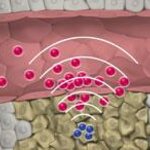Cancer Research

Cancer cells, like normal cells, begin to perish as soon as the temperature hits 43°C. So, the obvious challenge is to find out how cancer cells can be heated up without affecting the normal, healthy cells. One idea to deal with it, is known as magnetic hyperthermia. This involves injecting magnetic nanoparticles into the targeted tumors (For another nanoparticle approach to cancer, click here). Subsequently, the patient is put into a magnetic field that reverses direction several thousands of times each second. This excites the nanoparticles, heating them. Since the magnetic particles are…

By using two types of nanoparticles, drug delivery to tumors could be increased significantly. At the moment, several drug-delivering nanoparticles are already being used in clinical trials to combat tumors. A team at MIT decided to use two distinct particles, each with its own job, one to locate the tumor, and another one to deliver the drugs, all the while making use of the body’s own blood clotting system.
The ‘locator particle’ is a gold nanorod, which fits through the abnormally large pores of tumor blood vessels. When, subsequently, infrared light is shone on those gold particles, they…

A diet low in carbohydrates and high in protein may reduce the risk of cancer and slow the growth of tumors already present, according to a study published in Cancer Research. The study was conducted in mice but the scientists believe the strong biological findings warrant that a similar effect in humans can be considered.
Researchers implanted various strains of mice with human tumor cells or mouse tumor cells and assigned them to one of two diets. The first diet, a typical Western diet, contained about 55 percent carbohydrates, 23 percent protein and 22 percent fat. The second…

Conventional Canadian wisdom suggests that all women should have a screening mammogram starting at age 50 (age 40 in most of the USA). The reason given is that mammograms detect cancers earlier, while it is still possible to treat them. Instead of dying of cancer, you can be a “survivor”. It’s a powerful message preying on the fears of women and their families. October is “breast cancer awareness” month and the promoters of screening mammography were out in full force when I got the telephone call to come in and get my first mammogram. I left their message on my machine to think about it.
As…

A team of scientists say they have uncovered the basis for drug resistance in acute lymphoblastic leukemia, the most common form of childhood cancer. Acute lymphoblastic leukemia accounts for about 23 percent of all cases of cancer in children under the age of 15, according to the National Cancer Institute.
In this form of cancer, leukemia cells in the bloodstream and bone marrow continuously multiply, crowding out other, healthy cells. The disease progresses rapidly, and the leukemia cells begin to infiltrate tissues in other parts of the body. Treatment is neither cheap nor easy…

Cosmic Embryo #5: Aiming for the moon with all rockets blazing? A critique of Breast Cancer Deadline 2020®
The multibillion dollar breast cancer enterprise has just issued its damning self-assessment:
“Given the attention and resources directed to breast cancer, the public understandably believes that we have made significant progress. As this report shows, that is not the case. We know little about how to prevent breast cancer or how to prevent deaths from the disease.”
- Ending Breast Cancer: A Baseline Status Report. Washington,…

Normal
0
false
false
false
EN-US
X-NONE
X-NONE
/* Style Definitions */
table.MsoNormalTable
{mso-style-name:"Table Normal";
mso-tstyle-rowband-size:0;
mso-tstyle-colband-size:0;
mso-style-noshow:yes;
mso-style-priority:99;
mso-style-qformat:yes;
mso-style-parent:"";
mso-padding-alt:0in 5.4pt 0in 5.4pt;
mso-para-margin:0in;
mso-para-margin-bottom:.0001pt;
mso-pagination:widow-orphan;
font-size:10.0pt;
font-family:"Calibri","sans-serif";
mso-bidi-font-family:"Times New Roman";}
MANUSCRIPTS PUBLISHED/ACCEPTED IN PEER
REVIEWED JOURNALS
1. …

SUNNYVALE, California, May 11, 2011 /PRNewswire/ -- Accuray Incorporated , a global leader in the field of radiosurgery, announced today that 85 percent of European CyberKnife(R) centers are performing prostate SBRT to treat localized prostate cancer. There is an increasing trend towards treating prostate cancer patients with a hypofractionated regimen.
"More than 25 percent of our CyberKnife patients are being treated for prostate cancer with further growth anticipated," said Dr David Feltl, Head of the Oncology department, Ostrava University Hospital, Ostrava, Czech Republic.
At the…
I missed a cool paper last year on the effects of squid ink on angiogenesis--the growth of new blood vessels. And therefore I also missed the chance to run the sensationalist headline SQUID INK BLOTS OUT CANCER, or something equally punny and misleading.
Growing new blood vessels seems like a good thing, and indeed it often is. But, as the Angiogenesis Foundation points out:
Abnormal blood vessel growth, either excessive or insufficient, is now recognized as a “common denominator” underlying many deadly and debilitating conditions, including cancer, skin diseases, age-related blindness,…

CRAWLEY, England, April 27, 2011 /PRNewswire/ -- As image guided radiation therapy (IGRT) techniques have enhanced radiotherapy precision, Elekta continues working to decrease treatment session times through automated IGRT tools. Odense University Hospital (OUH, Odense, Denmark) clinicians are the first in the world to use a 3D seed matching feature of Elekta's Intuity(TM) IGRT package. The software quickly and automatically pinpoints the position of gold seeds that doctors implant in the prostate to confirm the organ's position before each treatment.
3D detection provides boost to proven…